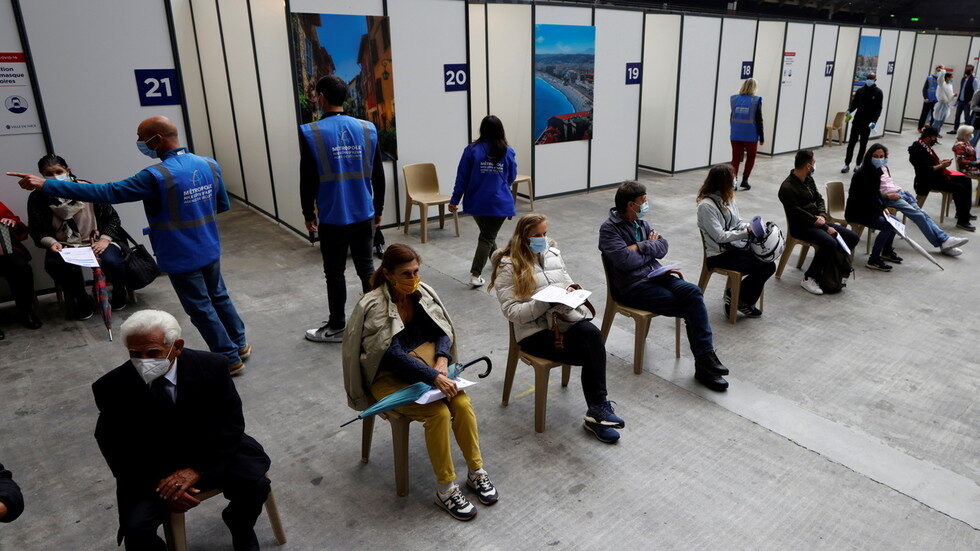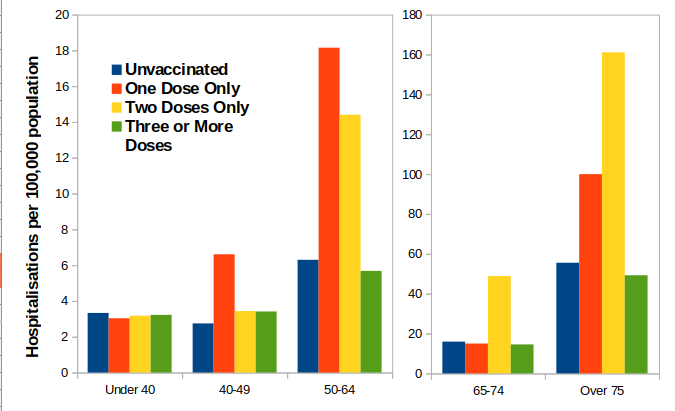
So imagine my surprise when in the most recent publication there was a little section tucked away near the end of the document reporting the number of hospitalisations for Covid by vaccination status. These data were gathered from the SARI-watch system, a nationwide surveillance system for England that gathers data on Severe Acute Respiratory Infections - thus these particular data are for those testing positive and who are being treated for a respiratory infection severe enough to warrant hospitalisation (i.e., for not with Covid as a primary diagnosis).
Of course, the big problem with raw numbers such as in the table above is that it doesn't factor in the numbers in the population for each age group and vaccination status; in order to gain a more useful understanding of the situation it is necessary to factor in the impact of population. Actually doing this is made more complex, however, because there are no official data on the number of unvaccinated in the U.K. - all we know is the number vaccinated and by how many doses and thus we need to use an estimate of the population for England to obtain the number unvaccinated. Many official data sources use the ONS estimate of the population - this is unsatisfactory as for a few age ranges there are more people vaccinated in the country than the ONS estimates are in the country. An alternative estimate of the population is to be found in the National Immunisation Management Service dataset, based on the number of people registered for healthcare in England. This dataset shows that around 19% of the adult population in the U.K. is unvaccinated - this is broadly compatible with (albeit still somewhat below) the survey undertaken by the BBC that showed that approximately one quarter (25%) of the adult population in the U.K. were unvaccinated.
Given the NIMS data on vaccination status for England we can thus calculate the hospitalisation rate per 100,000 population for the 90 day period covered in Table 13a in the UKHSA Vaccine Surveillance Report.
A few points immediately stand out:
- The hospitalisation rate by vaccination status for those aged under 40 is remarkably constant - for this age group the vaccines don't appear to offer any benefit.
- For all ages the hospitalisation rate in the triple vaccinated is broadly similar to the unvaccinated.
- The higher hospitalisation rates seen in all age groups above 40 for those having received only one or two doses of vaccine is troubling.
These data are consistent with recent reports from the Netherlands and Canada and with U.K. data on real-world effectiveness against death. They are also broadly consistent with data from ICNARC on intensive care admissions with COVID-19, once adjusted for the estimate of the unvaccinated in England (ICNARC uses the ONS population estimates in its own tables and graphs, resulting in an overestimation of the ICU admission rate for the unvaccinated). For the most recent data, February 2022, it shows the following admission statistics:
It would be nice to get an update from ICNARC on these statistics, as there was a general trend of increasing hospitalisations in the vaccinated as we entered the Omicron variant period. Unfortunately, it stopped updating the data just as it started getting interesting.
The UKHSA Vaccine Surveillance Report includes four pages on these vaccine surveillance data. It also includes 12 pages on reporting on the various estimates of vaccine effectiveness that have come from scientific studies. Of particular note is the estimate of vaccine effectiveness against hospitalisation with severe Covid.
It can be readily seen in the above table that the vaccines appear to be magnificent at protecting against hospitalisation, with the risk being reduced by between twofold (younger individuals, less severe) and tenfold (older individuals, more severe). It is difficult to square these estimates of vaccine effectiveness with the data that we see coming from SARI-watch and ICNARC. That said, there are at least two potential explanations: the impact of co-morbidities and prior infection. For the former, the impact of morbidities is diluted when looking at population-wide data; while it can have an effect it is unlikely to explain the large discrepancy seen between the hospitalisations data and the estimates of vaccine effectiveness. The impact of prior infections is perhaps more important - it is likely that the vast majority of individuals in the U.K. have now had at least one Covid infection and have developed a level of natural immunity to the complete virus (not just the highly mutable spike protein as offered by the vaccines) and this might explain the lack of any difference between the unvaccinated and triple vaccinated in the hospitalisation data. The increased hospitalisation rate seen in the data for one and two doses of vaccine remains difficult to explain, however.
'Science' is in many respects the use of experimental data to build theories to try to understand the real world. When experimental data and theoretical hypotheses disagree with what is seen in the real world the answer is to try harder to fully understand what is going on, not to declare that it is the experiments and theories that are right and that it is the real world that is wrong.
This post has been corrected. An earlier version used a figure of 8% for the percentage of over-75s unvaccinated in NIMS; the correct figure is 5%. The overall argument is unaffected.
Amanuensis is an ex-academic and senior Government scientist. He blogs at Bartram's Folly.







hell will certainly be packed to the high cave walls thats a fact.. just listen to all these sick fks clapping, 4x satan II
will sink the UK, this is the future of the UK..
people must unite now, all over the world, gather in groups, large ones, drag these scum from there homes and hang them..
She freaked out at the sight of a fainted person. {TRUSS, UK FUTURE PM} She was frozen, paralyzed. She was gasping for air. She did not know what to do, and you think she can handle a national crisis?
no f*cking way
[Link]